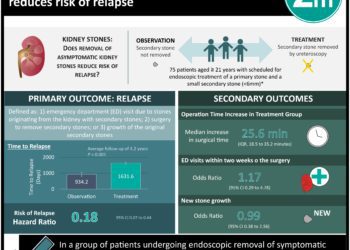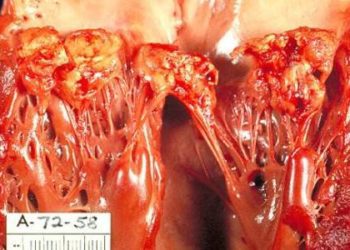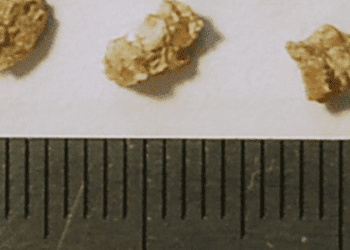Lower rates of repeat intervention following ureteroscopy for kidney stones
Image: PD
1. 18.7% of patients undergoing ureteroscopy required a second procedure to fragment or remove a kidney stone, compared to 23.6% for patients who underwent shockwave lithotripsy.
2. After adjusting for confounders to approximate a marginal patient with kidney stones, the rate of a repeat procedure for patients undergoing uteroscopy was just .33%, compared to a rate of 11.0% for patients undergoing shockwave lithotripsy.
Evidence Rating Level: 3 (Average)
Study Rundown: Kidney stones are an increasingly prevalent and economically burdensome health issue, affecting approximately 1 in 11 individuals in the United States with a 50% rate of 5-year recurrence. First line therapy typically involves either non-invasive shock wave lithortripsy (SWL) or minimally invasive ureteroscopy (URS). While previously published studies have suggested a lesser efficacy of SWL, such analyses do not reflect the current state of the technology or technique of these two interventions and does not account for some potentially confounding variables which currently govern selection of each procedure. In this study, patients undergoing URS demonstrated a lower rate of repeat surgery compared to patients receiving SWL. This difference in rates of repeat surgery was widened when adjusted for observed and non-observed variables by econometric modeling, in which 11.0% of SWL patients required a second procedure, compared to just 0.33% of URS patients. While such a result does provide evidence for URS as a more effective treatment of kidney stones, there are certainly constraints on the generalizability of these findings. The statistical adjustment used by the authors only applies to a “marginal” patient who could undergo either treatment option. The results, consequently, could not be applied to patients for whom current treatment guidelines are specific for either SWL or URS. Selection bias was also introduced through the use of the particular data set. All patients included were otherwise healthy and had private insurance, which precluded the uninsured and government-insured population, such as those covered by Medicare who are often an older demographic.
Click to read the study in JAMA Surgery
Click to read an accompanying editorial in JAMA Surgery
Relevant Reading: A prospective randomised trial comparing the modified HM3 with the MODULITH® SLX-F2 lithotripter
In-Depth [retrospective cohort]: 47,851 patients who visited emergent care and received treatment to fragment or remove a kidney stone were selected for inclusion in the study from the MarketScan Commercial Claims and Encounters data set. 21,937 patients underwent SWL and 25,914 underwent URS. 23.6% of patients receiving SWL and 18.7% of patients receiving URS required a repeat procedure (p<.001). The researchers employed an econometric bivariate probit model to adjust for any potentially confounding factors. These included both observed variables, such as age and comorbidities, and non-observed variables, such as the size of the implicated stone. After adjustment, the rate of recurrence for a marginal patient was found to be 11.0% for SWL and 0.33% for URS (p<.001).
More from this author: Increased incidence of stroke found after aortic valve replacement, Decreased breast cancer recurrence and mortality following post-mastectomy radiotherapy
©2012-2014 2minutemedicine.com. All rights reserved. No works may be reproduced without expressed written consent from 2minutemedicine.com. Disclaimer: We present factual information directly from peer reviewed medical journals. No post should be construed as medical advice and is not intended as such by the authors, editors, staff or by 2minutemedicine.com. PLEASE SEE A HEALTHCARE PROVIDER IN YOUR AREA IF YOU SEEK MEDICAL ADVICE OF ANY SORT.






